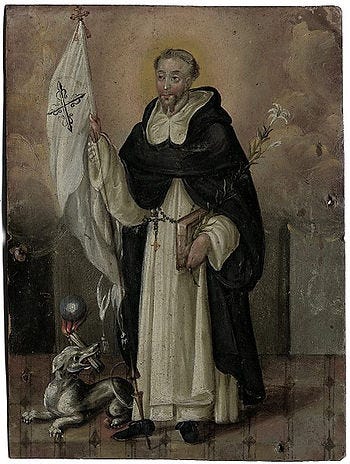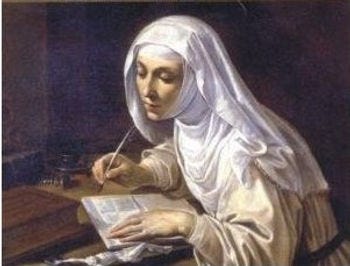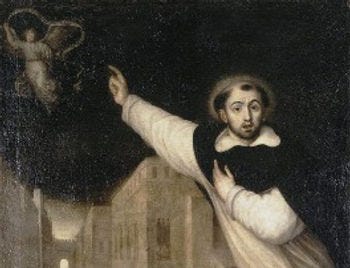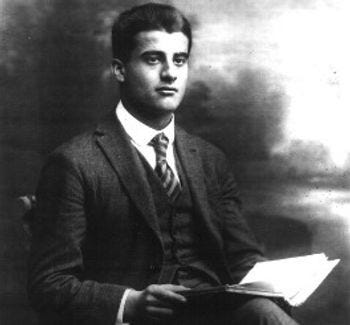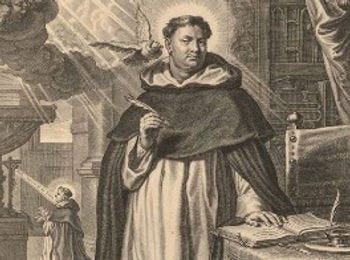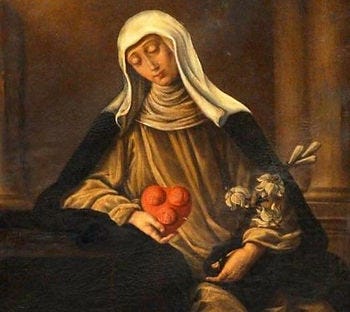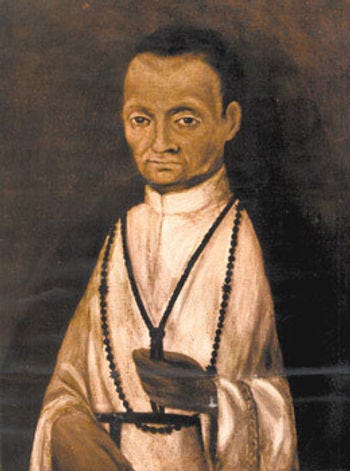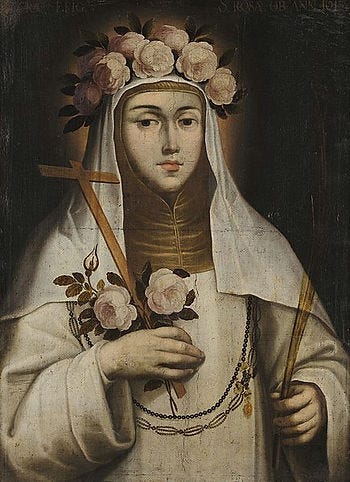The Third Order of St. Dominic & My Dominican Vocation
What is the Third Order of St. Dominican, and why I joined it.
"The Dominican Order is one family within the City of God, a cell or a member of the Mystical Body, a branch of the True Vine. Under God's providence St. Dominic brought it into being at a definite moment in history in order to fulfil a definite function in the Church. The children of this family of St. Dominic, forming themselves on the traditions and examples of seven centuries, are bound together within God's Church by ties that transcend differences of race and tongue and are more enduring than the bonds of earthly kinship." - Bernard DeLaney, OP
An Explanation of the Dominican Order
St. Dominic himself established the Ordo Praedicatorum (Order of Preachers) in the year 1215.
First Order: The Friars are formally designated as the "First Order," they are the brothers and priests.
Second Order: The Nuns are designated as the "Second Order," who trace their origin back to St. Dominic when he founded a monastery for women at Prouille. These nuns take solemn vows and live an enclosed, contemplative life of prayer.
Third Order: Lay people who associate themselves with the friars.
Now, there are two types of Third Order:
Secular, who today are most commonly known as "Lay Dominicans," (a term that came into use in 1972)
Regulars who are congregations that live in community but are not enclosed.
Those belonging to the Third Order are also known as Tertiaries.
The term tertiary comes from the Latin tertiarius, meaning "third."
History of the Third Order
To describe the history of the Third Order, I am simply going to quote from The Manual of the Brothers and Sisters of the Third Order of Penance of St. Dominic, published in 1852:
"Heresy is a many-headed monster, which, though ever beaten, is ever found to rise again with recovered life, if it be not vigorously attacked. The Blessed St. Dominic having labored for ten years in combating that of the Albigenses, saw with sorrow, in his journeys through France, Italy, and Spain, an immense number of heretics ... Our sainted patriarch, burning with zeal for the glory of his God, undertook to establish an order composed of men of exemplary piety, who should take up arms when lawfully commanded, in order to oppose themselves to the sacrileges and the violence of the heretics. This was the beginning of our Third Order. He prescribed to them a rule of life, and fixed a certain number of Pater nosters and Ave Marias to be daily recited in place of the canonical hours. He gave them a modest habit of black and white; and even engaged those who, with their wives, had sufficient virtue to consent, to live in the state of continence. It was called at first the Militia of Jesus Christ; but after the death of its sainted founder ... those who embraced it were called the Brothers of Penance of St. Dominic. This name is given them in a bull addressed to them in the year 1228 by his Holiness Pope Gregory IX."
"When St. Dominic saw that the wives of those who had joined themselves to the Third Order were inclined to practise all its pious exercises no less than their husbands, he associated them also to his consecrated militia ; not, indeed, to follow the army, nor to fight, but to give themselves up to prayer, to the works of mercy, and the practice of all the Christian virtues ; engaging them to follow the same rule and form of living that he had before prescribed to their husbands. Their fervor and edifying lives had so great an influence, that vast numbers both of widows and maidens requested the same favor for themselves; and we read in our annals, that early in the 13th century the order was thus multiplied in an extraordinary manner."
This history, which I am inclined to agree with, asserts that it would be absurd to think that St. Dominic would form this Order and then not give them a Rule to live by.
"For we cannot suppose that this great Saint, who had given constitutions so holy and so judicious to his religious and his beloved daughters of Prouille, the first convent of his order, would have established his Third Order without prescribing to it a form both of living and of government. This rule, indeed, was not written; and after a lapse of years, when the order had spread itself throughout Italy and Spain, many of its directors introduced particular practices and ceremonies, which, not being in conformity with the common statutes, caused so great a confusion, that the Sisters of Italy urgently besought the Yen. Father Munio de Zamora, the seventh General Master of the order, to reduce this rule into writing, that thus that uniformity might be restored, which they so ardently desired. He complied with their request and divided into twenty-two chapters the rule which St. Dominic had only given verbally; and that it might not be lawful for any one to make the least change in it, he obtained its confirmation from the Pope, who forbade the brethren and sisters to observe any other."
Dominican Mottos:
“Vertias” - Truth
“Laudare, Benedicere, Praedicare” - To praise, to bless, to preach
"Contemplare et contemplata aliis tradere" - Written by St Thomas Aquinas in his Summa, it means, “to contemplate and share with others the fruits of contemplation.” The phrase has come to express the essence of the vocation and spirituality of the Dominicans, and quickly became one of the principal mottos of the Dominican Order.
"For even as it is better to enlighten than merely to shine, so is it better to give to others the fruits of one's contemplation than merely to contemplate."
- Summa Theologiae II-II q. 188, a. 6
What is the Purpose of Third Order?
By observance the Rule and under the direction of the Order, members of the Third Order strive to attain to Christian perfection. The end of a Dominican vocation is to live the Christian life in a more perfect manner. Thus, the primary goal of the Third Order is the sanctification of its members by the practice of a more perfect form of Christian life.
The secondary object is to assist the Church in the salvation of souls.
How is this Accomplished?
The means of attaining this end, are by the ordinary precepts and duties proper to one’s state in life, as well as:
prayer (especially liturgical prayer)
penance
study
works of charity (according to one’s particular state or condition in life)
observance of the Rule.
What is the Rule?
The first definite rule was written down in 1285 by Munio of Zamora.
Ven. Munio was not the author, but merely the editor and compiler of this rule; for, as previously pointed out, "one cannot believe that the Third Order, which was in so flourishing a state in the year 1228, which Pope Gregory IX. honored with great privileges in the same year, and which had a renowned monastery of virgins in 1255, had existed without a rule or statutes until the year 1285.”
The original Rule, as given from St. Dominic and written down by Munio, remained unchanged until 1923, when it was first revised by Pope Pius XI.
This rule remained until Vatican II, when a new Rule was needed to conform to the changes of the Counsel.
After that, the Rule has been continually tweaked here and there.
13th C.: First Rule
1923: Second Rule
1964: Third Rule
1968: Fourth Rule
1987: Fifth Rule
2019: Sixth and Current Rule
What I provide here is mostly from the current Rule, but for my own personal reasons, I also incorporate a few things from the 1923 Rule as quoted from the excellent book, Dominican Life, by Joret.
In trying to live out the duties of my Dominican vocation and incorporate its spiritually into my daily life, this is how I find it most helpful to organize it:
The precepts of the Rule do not oblige under pain of sin before God.
Tertiaries shall recite daily either the Divine Office, or the Little Office of the BVM, or the fifteen mysteries of the Rosary. If unable to satisfy the above obligation, any one of the Little Offices approved by the Order may be recited, or even a third part of the Rosary.
Tertiaries shall, unless legitimately hindered, approach the Sacraments of Penance and the Holy Eucharist at least twice a month.
Every possible effort should be made to assist daily at the Holy Mass, and to piously and attentively unite with the priest celebrating it.
The Four Pillars of Lay Dominic Life that give shape to Lay Dominic spirituality:
Prayer
Study
Preaching
Community
Daily Duties
Prayerful reading of Sacred Scripture, especially of the New Testament.
Daily Mass, if possible.
Divine Office or Little Office of BVM or 15 decades of rosary, or 5 decades if one is impeded from doing more.
Daily recitation of the Rosary
Daily Pater, Ave, and Eternal Rest for the living and the dead of the whole Order
Penance offered for the success of the preaching of the Order.
Weekly Duties
Fast and abstain from meat all Fridays of the year
Monthly Duties
Attendance at Chapter meeting
Yearly Duties
Annually have offered or assist at three Masses for the welfare of the Brothers and Sisters, both living and dead.
It is greatly desired that a retreat (not less than 3 days) be made once a year.
Fasting and abstinence on the following Vigils: Holy Rosary, St. Dominic, St. Catherine
On the Death of a Member
Attendance at funeral Mass, if possible
Within 8 days, offer a Mass, pray a Rosary, or apply one Holy Communion to the soul of the deceased.
Recite the appropriate Hour of the Office of the Dead together at the next Chapter meeting following the death.
Preaching
Prayerful preaching in ways appropriate to the laity
Acts of charity with attention to the four priorities of the Order: catechesis, evangelization, justice and peace, and communication.
Study
Prayerfully study Scripture, theology, Church doctrine and history, and reflectively read the lives of the Saints, especially those of the Dominican Order.
Community
Common study and reflection on sacred Truth
Concern for the good and well-being of the Chapter and its members
Common observance of the customs and celebrations of the Order
General
Let them behave with great reverence in the Church and be an example to all the faithful.
Let them be particularly devoted to the Blessed Virgin Mother, to St. Joseph, to St. Dominic, to St. Catherine of Siena, and to all the Saints and Blesseds of the Order.
Tertiaries should abstain from frequenting places of worldly amusements.
Tertiaries should be animated with an ardent and generous desire for the glory of God and the salvation of souls.
Tertiaries should labor by word and deed for the truth of the Catholic Faith, for the Church and the Roman Pontiff, proving themselves valiant defenders in everything and always.
Let them also assist in apostolic works, especially those of the Order.
They should help the parish priest in the works of the parish and particularly, where it is necessary, in giving religious instruction to children.
What Attracted Me to the Order
More than anything, it was their motto "Veritas." I used to suffer from debilitating depression, and it is the distinction between truth and feelings that has always kept me living. Feelings are fleeting, but the Truth is eternal.
"A Dominican soul even more than others, must shun falsehood and dissimulation. What could be more illogical than a lack of truth on the part of one who displays Veritas as his motto?" - Joret.
Also because they are the order of Study and Preaching. What I love is that study is never meant to be for selfish gain, rather it is meant to be ordered toward truth for the salvation of souls. "Knowledge, in the true sense, is concerned only with truth." - St. Thomas Aquinas. Dominicans study and share the fruits of their study in order to help the Church save souls with God's truth.
As I delved into the Order and began my formation, I realized that the Dominican Rule has been a guiding force for many holy men and women throughout history, leading their souls to sainthood. This inspired me to adopt it as my guide too. Living in the secular world, I aspire to achieve Christian perfection by embracing the spirit of the Dominican order.
How I Became a Dominican
Reflecting on the past, I can see how God was guiding me towards Dominicans vocation over several years, even though I was unaware of it at the time.
The first Lay Dominican to cross my path was when my daughter was born very sick. My mother gave me a first class relic of then Bl. Margaret of Castello (now St. Margaret). The reason my mother gave me the relic is because my daughter was born with many deformities, and Margaret of Castello was also born with many deformities. Margaret's parents abandoned her due to her condition, but Margaret eventually became a Lay Dominican, and she has since been canonized as a saint.
The next Lay Dominican to come into my life was when I was struggling with much of the scandals going on within the Church. It was reading a biography of St. Catherine of Siena that helped me to understand and accept that the Church can endure such difficult and mysterious situations, yet continue to be the true Church, worthy of fidelity and loyalty. Yet, at the time that I read it, I did not fully understand that St Catherine of Siena was a Lay Dominican, because I did not know what that meant! In her paintings she is always depicted wearing a habit, and so I assumed that she was a nun. I did not understand that she belonged to the Third Order.
At the same time, I utilized a "saint name generator" to select a patron saint for the New Year. The saint I received was Blessed Pier Giorgio Frassati. Initially, I knew very little about him. I promptly acquired a biography and resolved to adopt him as my friend for the new year. I soon discovered that Frassati was a Lay Dominican and held a devotion to St. Catherine of Siena.
The next Lay Dominican to come on my radar was Blessed Bartolo Longo. He caught my attention at a relic exposition where his relic was displayed. What particularly struck me was the brief biography beside it, which mentioned his past as a satanic priest before he returned to the faith and became an advocate for the rosary. Some years later, I listened to a priest deliver a detailed homily about his life and his story turned out to be even more astonishing than I initially thought. It continues to be one of my favorites to this day.
It's clear that I was consistently drawn to Dominican Saints, yet the pattern escaped my notice. In fact, I still didn't even know what being a Lay Dominican meant.
As I delved deeper into my Catholic faith, I found myself inexplicably drawn to philosophical and theological questions. Although I was not an intellectual and lacked formal education, I was determined to read the Summa Theologica by St. Thomas Aquinas.
At this time, the rather recent discovery of the Latin Mass had enriched and deepened my spiritual life, igniting a fervent zeal for my faith. I was eager to share this faith with others. However, my enthusiasm was not always paired with charity. Unintentionally, I came across as somewhat harsh and abrasive. My attempts to educate others about the faith were not always well-received, and I neither made many friends nor converted anyone. :')
Whenever Mormons or Jehovah's Witnesses came to my door, I found myself genuinely excited. I would welcome them inside, take out a Bible, and engage in lengthy discussions. I dedicated considerable time to study, aiming to enrich our conversations. Clearly, the urge to learn and share the truth with others was stirring within me, even before I discovered Dominican spirituality.
I once managed a pro-life blog aimed at persuading pro-choice individuals to reconsider their stance. I would create posts and encourage pro-choice visitors to debate with me in the comments. My passion was fervently directed towards combating abortion; among all the various social justice issues, it was the one I dedicated most of my efforts to. Eventually, I had to take down the blog due to receiving death and rape threats.
I also had a great love for volunteering. When my daughter was born, I learned a lot about how to take care of a medically fragile child, and this sparked an interest in a nursing career. It was a short-lived dream because I realized that I wanted to stay home with my children. So instead, I volunteered two nights a week volunteering in the children's ward at the hospital. After this, I became part of a Catholic charity that provided assistance to the elderly, which included driving them to the grocery store and aiding them with their shopping.
In my church, a friend, who belonged to the Third Order of Carmelites, encouraged me to join her in volunteering at the local crisis pregnancy center. It quickly became some of the most rewarding volunteer work I've ever done. My role involved manning the front desk, answering phone calls, connecting women to resources, welcoming guests and assessing their needs, and providing them with essentials like diapers, wipes, clothing, blankets, car seats, playpens, and food. I cherished this work deeply, and I've often thought that once my children are grown and I've finished raising them, it would be a dream come true to start a center of my own.
And so, without even understanding what a Lay Dominican is, I was already:
attracted to Dominican Saints,
reading the Summa for fun,
zealously preaching to others in order to convert them,
and volunteering my time to help the poor and sick.
Discovering the Dominicans
Eventually, my husband and I were finally in a position to move back to our home state. My husband had been in the military, and we had been moving all over the country. Now it was finally time to move home.
This was not an easy move for me: the place that we moved from had a wonderful, traditional parish; we had a wonderful, traditional school for our children; I had a wonderful group of friends. When we moved, I lost all of it. It was like my traditional bubble burst and I was thrown into a diocese that was not so friendly towards tradition. The traditional practices of my faith were viewed with skepticism and sometimes even disgust. I felt ostracized from the local Catholic community almost immediately.
I had always suffered from depression to some degree before this, but the move, with all the big changes and all the disappointment I was experiencing, culminated into a very bad depressive episode in which I ended up in the hospital.
Due to the challenges with my mental health, I was unable to continue homeschooling my children and made the decision to enroll them in a Catholic school. Like I said, the diocese we lived in was not very traditional, and I was not entirely comfortable putting them into a diocesan school, but I also felt like I had no choice. I did some research and picked the school that I felt was the best possible choice. Unfortunately, it was bit of a drive from the house. So, every day I was driving quite a distance in order to take my children to school each morning…
When I left the house in the morning, I would tune into a local Catholic radio station. I started to notice that every Tuesday morning, the Lay Dominicans would have a brief segment on the air. I might not have given much thought to these segments if it weren't for the speaker being someone I recognized from my childhood. The moment they mentioned his name and his voice came through, I knew him as a friend of my parents and someone familiar from my youth. As a child, I was unaware that he was a Lay Dominican. However, knowing him personally drew my attention more to what was being said in these segments.
Every week, I listened to the Lay Dominicans on the radio, and they would extend an invitation to their chapter meetings. I can't quite explain it in natural terms, but I felt so compelled to just go to a meeting. For an introvert like me, it's highly out of character to arrive uninvited at a place where I don't know anyone. But that's exactly what I did—I attended their next chapter meeting.
Right away, everyone was very kind and welcoming. They gave me a binder full of information and I started my formation process right away. As soon as I started reading the information that they gave me, I knew immediately that this was for me. It was almost like I discovered my spiritually had a name, and that name is Dominican.
From that first day, I loved everything about it. I loved their emphasis on truth, I loved their love of study, and I loved that knowledge was never gained for selfish purposes but only for the sanctification of one's self and others. I loved that the fruits of contemplation were meant to be shared with others, so that others could benefit from it. I loved that it was all centered around the salvation of souls; firstly, my own, but then others. I knew immediately that this was something that I wanted to be a part of.
And to bring everything back full circle, my local chapter is named after St. Margaret of Castello. The first Lay Dominican to cross my path and of whom I have a first class relic.
"God grant that I may always be a lover and proclaimer of truth, and that for the sake of truth I may die." - St. Catherine of Siena (Letters, 277).
How Can a Busy Wife and Mother Have a Third Order Vocation?
The number one question people ask me in regard to being a Third Order Dominican is how do you have the time?
First of all, the purpose of the Third Order is the sanctification of its members, and we are primary sanctified through the fidelity to our daily duties according to our state in life. Since I am in the married state, my primary duties are those of the married state. I live according to the Rule to the extent that it is possible given my state in life, and that is enough.
Secondly, the Rule is not binding under pain of sin. This means that if I cannot fulfill any part of the Rule for some reason, it is no sin before God. If I don't have a chance to pray Lauds because I'm taking care of a child: no problem. Nothing about the Rule is so binding that I would be made to feel the guilt of sin should I not be able to tend to it.
Do you have to be a theologian to be a Dominican?
Absolutely not. When people think of Dominicans, they tend to think of the great Dominican preachers and theologians; however, there were many Third Order Dominicans who were not highly intellectual or learned people.
Whenever people come to me with interest in the Third Order, the first thing I do is recommend that they start reading biographies of Third Order saints.
Here are some well-known Third Order Dominicans from various walks of life:
St. Catherine of Siena: a great mystic and Doctor of the Church; instead of joining a convent, she joined the Third Order of St. Dominic, which allowed her to associate with a religious society while still living at home.
St. Rose of Lima: a member of the Third Order of Saint Dominic in Lima, Peru, who became known for both her life of severe penance and her care of the poor. Rose's Dominican vocation was revealed to her through miraculous means. Like Catherine, she joined the Third Order and was associated with the religious society, but remained living at home with her family. Embroidery and gardening were ways for her to help provide income for her family.
St. Martin de Porres: a Peruvian lay brother of the Dominican Order. He was known for his virtues, practice of austerity, patient care of the sick, and love of the poor.
St. Juan Macias: entered a Dominican convent in Lima as a lay brother who would do the manual labor necessary in the monastery. Juan was the assistant Porter (doorkeeper) until his death. Although he was uneducated, Juan still exemplified the Dominican charism.
St. Margaret of Castello: born with severe disabilities, she was abandoned by her parents. She was accepted as a secular member in the Dominican third order. Despite being blind and disable, she started a school for children to teach them the faith and often took care of children while their parents were out at work.
St. Louis de Montfort: in his desire to preach the Rosary more effectively, he entered the Dominican Third Order in 1710.
Bl. Pier Giorgio Frassati: a young, Italian man who joined the Third Order in 1922. He was known for his commitment to prayer and study, his devotion to the Blessed Sacrament, and a tender love of the Blessed Mother. He had a generous heart for the poor.
Bl. Bartolo Longo: a satanic priest who was led out of his errors by a Dominican priest. Bartolo suffered from suicidal thoughts, but he rejected them by recalling the promise of Our Lady to St. Dominic: "He who propagates my Rosary will be saved." Longo wrote that this promise is what convinced him to encourage public devotion to the Rosary. Bartolo was received as a lay Dominican, taking the name Rosario.
Ven. Benoîte Rencurel: was a French girl who lived in extreme poverty, yet was favored with a vision of Our Lady who came with a message of penance and requested a chapel to be built. Benoite took a modest house near the chapel, became a Third Order Dominican, and ministered to pilgrims and penitents who came to the chapel.
Praxedes Fernandez was a 20th century Spanish wife, mother, widow, and Lay Dominican whose cause for beatification is open.
Did you take a Dominican name?
I did.
At first, I was set on the name Jane, after Bl. Jane of Aza. She was St. Dominic's mother. I have always felt that my life is meant to be a quiet, hidden one - that I will never amount to much, because it is not God's will. But perhaps by living a holy life, even if it unseen and unknown to the world, I will set a good example for my children, and they can go on to be great saints. There are several saintly mothers like this who remain "behind the scenes" - Monica, Aleth, Jane - and I thought perhaps it would be best to identify myself with Bl. Jane, Dominic's mother, rather than with a prominent Dominican.
And yet, in the end, my heart felt moved to choose Rose, after St. Rose of Lima. For a time, I even tried to embroider and grow flowers in her honor, but so far I have not been blessed with her skills.
What is your Dominican community like?
We meet once a month.
At our monthly meetings, we pray the Divine Office together, followed by the Rosary. We have lunch and listen to some talks. The Prior always gives a talk first, and then there is one or two other speakers (members of the Chapter who have prepared talks). One year, we all took turns giving talks about Dominican saints. Another year, we all took turns talking about different virtues. Often, we are given books to read, and then we will discuss at the meetings. After the talks, there is opportunity for questions and discussions.
Sometimes we have the honor of having a Dominic priest visit us and give us a talk. This is always a special occasion.
Once a year, the Chapter hosts a day retreat. It’s kind of like a really long Chapter Meeting. We are together all day and have Mass, Breakfast, Morning Prayer, the Rosary, several talks given by a Dominican priest, lunch, more talks, discussions, etc.




